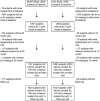Multiple Nonspecific Sites of Joint Pain Outside the Knees Develop in Persons With Knee Pain
- PMID: 27589036
- PMCID: PMC5292971
- DOI: 10.1002/art.39848
Multiple Nonspecific Sites of Joint Pain Outside the Knees Develop in Persons With Knee Pain
Erratum in
-
Middle Initial Omitted From Author Name in the Article by Felson et al (Arthritis Rheumatol, February 2017).Arthritis Rheumatol. 2017 Apr;69(4):862. doi: 10.1002/art.40096. Arthritis Rheumatol. 2017. PMID: 28371559 No abstract available.
Abstract
Objective: Many persons with knee pain have joint pain outside the knee, but despite the impact and high frequency of this pain, its distribution and causes have not been studied. We undertook this study to test the hypothesis of those studying gait abnormalities who have suggested that knee pain causes pain in adjacent joints but that pain adaptation strategies are highly individualized.
Methods: We studied persons ages 50-79 years with or at high risk of knee osteoarthritis who were recruited from 2 community-based cohorts, the Multicenter Osteoarthritis Study and the Osteoarthritis Initiative, and we followed them up for 5-7 years. We excluded those with knee pain at baseline and compared those who had developed knee pain at the first follow-up examination (the index visit) with those who had not. We examined pain on most days at joint regions outside the knee in examinations after the index visit. Logistic regression analyses examined the risk of joint-specific pain adjusted for age, sex, body mass index, and symptoms of depression, and we performed sensitivity analyses excluding those with widespread pain.
Results: In the combined cohorts, 693 persons had knee pain at the index visit and 2,793 did not. A total of 79.6% of those with bilateral knee pain and 63.8% of those with unilateral knee pain had pain during follow-up in a joint region outside the knee, compared with 49.9% of those without knee pain. There was an increased risk of pain at most extremity joint sites, without a predilection for specific sites. Results were unchanged when those with widespread pain were excluded.
Conclusion: Persons with chronic knee pain are at increased risk of pain in multiple joints in no specific pattern.
© 2016, American College of Rheumatology.
References
-
- Shakoor N, Block JA, Shott S, Case JP. Nonrandom evolution of end-stage osteoarthritis of the lower limbs. Arthritis Rheum. 2002;46(12):3185–9. - PubMed
-
- Farquhar SJ, Reisman DS, Snyder-Mackler L. Persistence of altered movement patterns during a sit-to-stand task 1 year following unilateral total knee arthroplasty. Phys Ther. 2008;88(5):567–79. - PubMed
-
- Hodges PW, Tucker K. Moving differently in pain: a new theory to explain the adaptation to pain. Pain. 2011;152(3 Suppl):S90–8. - PubMed
Publication types
MeSH terms
Grants and funding
LinkOut - more resources
Full Text Sources
Other Literature Sources
Medical



